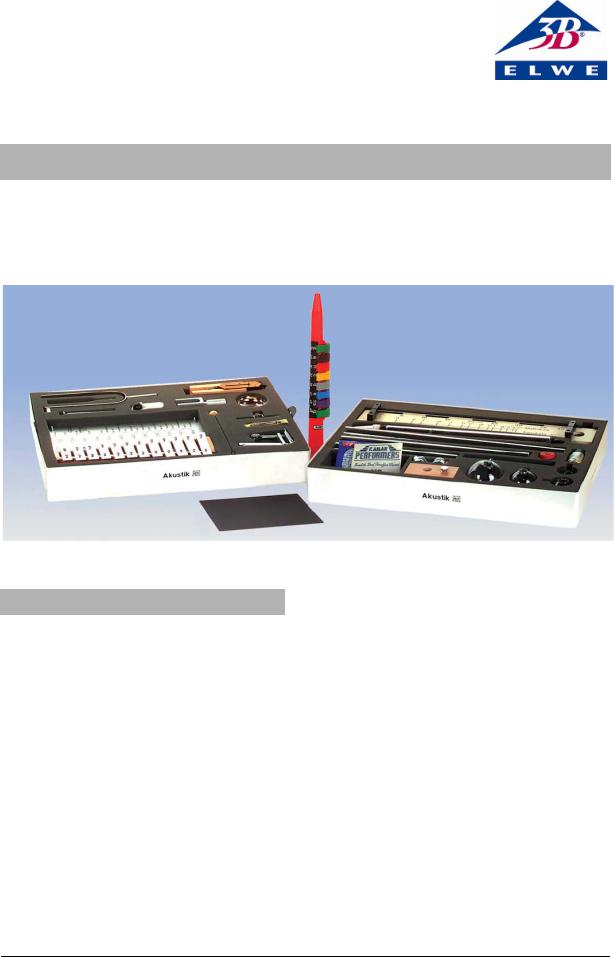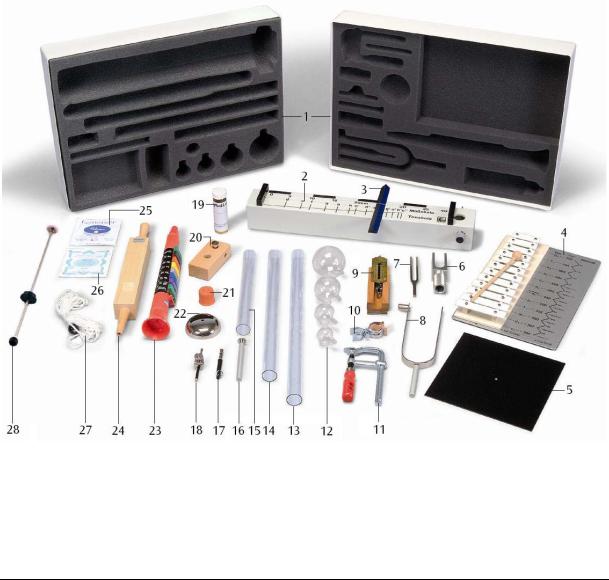3B Scientific Acoustics Kit User Manual

3B SCIENTIFIC® PHYSICS
Acoustics Kit U8440012
Instruction sheet
05/09 ELWE/ALF
1. Description
This set of apparatus makes it possible to impart an extensive and well-rounded overview on the topic of acoustics. The set can be used for conducting numerous experiments.
Sample experiments:
1.String tones
2.Pure acoustic tones
3.Vibrating air columns
4.Open air column
5.Whistle
6.Vibrating rods
7.Infrasound
8.Ultrasound
9.Tuning fork with plotter pen
10.Progressive waves
11.Doppler effect
12.Chladni figures
13.Chimes
14.Standing waves
15.Overtones
16.Measurement of wavelength
17.Soundboard
18.Resonator box
19.Spherical cavity resonator
20.Stringed instruments and the laws they obey
21.Scales on stringed instruments
22.Measurement of string tension
23.Relation between pitch and string tension
24.Wind instruments and the laws they obey
25.C major scale and its intervals
26.Harmony and dissonance
27.G major triad
28.Four-part G major chord
29.Major scales in an arbitrary key
30.Introduction of semitones
The set is supplied in a plastic tray with a foam insert that facilitates safe storage of the individual components.
1

|
2. Contents |
17 |
Galton whistle |
|
|
18 |
Plotter pen with holder |
||
|
|
|||
1 |
Trays with foam inserts for acoustics kit |
|||
19 |
Lycopodium powder |
|||
2 |
Monochord |
20 |
Plastic block for clamp |
|
3 |
Bridge for monochord |
21 |
Rubber top |
|
4 |
Metallophone |
22 |
Bell dome |
|
5 |
Chladni plate |
23 |
Reed pipe |
|
6 |
Tuning fork, 1700 Hz |
24 |
Whistle |
|
7 |
Tuning fork, 440 Hz |
25 |
Steel string |
|
8 |
Tuning fork with plotter pen, 21 Hz |
26 |
Nylon string |
|
9 |
Spring balance |
27 |
Resonance rope |
|
10 |
Retaining clip |
28 |
Plunger |
11Table clamp
12Helmholtz resonators 70 mm dia.
52 mm dia.v
40 mm dia.
34 mm dia.
13Glass tube for open air column
14Kundt’s tube
15Glass tube for closed air column
16Rod for Chladni plate/bell dome
2

|
3. Technical data |
|
|
Dimensions: |
530 x 375 x 155 mm3 approx. |
Weight: |
4.5 kg approx. |
4.Sample experiments
1.String tones
•Pluck the monochord string hard when it is moderately taut.
•Subsequently increase the tension on the string by turning the peg to the right. Pluck the string again.
At first, a low tone is heard. As the string is tightened the tone gets higher.
Reasons: vibrating strings generate acoustic tones by inducing alternating compression and rarefaction of the surrounding air. The greater the tension in the string, the faster the vibrations are and the higher the tone.
2. Pure acoustic tones
•Hit the 440 Hz tuning fork hard with the metallophone beater.
A pure acoustic tone of a very specific, unchanging pitch can be heard. This tone dies away very slowly.
Reasons: a tuning fork consists of a U-shaped steel piece which merges into the stem at its vertex. As the tuning fork only vibrates in one oscillation mode (with both prongs either both moving apart or both moving towards one another), it produces a pure tone of an unchanging pitch. Owing to its property of producing a constant pitch, tuning forks are used for tuning musical instruments.
3. Vibrating air columns
•Attach the glass tube for demonstrating a closed air column by means of the table clamp, plastic block and retaining clip.
•Insert the tuning plunger into the glass tube.
•Hit the 440 Hz tuning fork hard with the metallophone beater. By pulling out the plunger to a greater or lesser degree it is possible to alter the length of the closed air column.
There is only one plunger position at which the air column resonates strongly. At any other position there is no sound. Resonance can be detected by the increase in sound volume.
Reasons: a closed air column starts resonating when its length corresponds to one quarter of the excitation wavelength. The tuning fork vibrates with a frequency of 440 vibrations per second. Applying the following equation:
Wavekength = |
Speedofpropagation |
||
Frequency |
|||
|
|||
34000 cm / s |
|||
|
|
= 77.2 cm |
|
440 Exciting |
freq / s |
||
the wavelength of the tone produced is 77.2 cm. One quarter of this wavelength is therefore 19.3 cm.
The distance between the plunger and the opening at the end of the tube is 19.3 cm when resonance occurs.
4. Open air column
•Conduct the same experiment with an open air column (14).
The open air column, which is exactly double the length of the closed air column, starts resonating when the tuning fork is brought into its vicinity, as can be heard by means of the increased volume.
Reasons: an open air column starts resonating when its length is half that of the wavelength or multiples of that length. Antinodes are formed at the ends of the open air column and a node at the middle.
5. Whistle
•Blow the whistle and change its length by gradually drawing out the plunger.
Depending on the length of the whistle, its note gets higher or lower but the character or timbre of the note remains the same.
Reasons: blowing a uniform air stream into the opening of a whistle causes the air trapped in the pipe to vibrate and eddies then occur at regular intervals air the air passes over the blade. The resulting tone depends on the length of the air column. In the case of a closed air column, the length of the whistle (measured from the edge of the blade to the base of the whistle) corresponds to a quarter wavelength of the base tone. A node is formed at the blade of the whistle and an antinode is formed at the end of the pipe
6. Vibrating bars
•Use the striking hammer supplied to strike several bars of the metallophone. When the metal bars are struck, they produce a distinct, melodious note, each of which has a similar timbre. The shorter the length of the bar, the higher the tone.
Reasons: elastic rods form systems capable of oscillating if they are resting upon a point where a node is formed (about 22% of the total length between the two ends).
3
